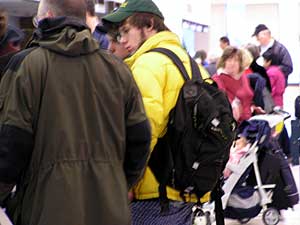|
Audio
Photos
More from MPR
Resources
Respond to this story
|
South Dakota's population growth is slow and steady
December 31, 2004
Population estimates for South Dakota show slow, steady growth. For a state that's fourth from the bottom in population rankings, growth is important. This year, South Dakota replaced Minnesota as the fastest-growing state in the upper Midwest.
Sioux Falls, S.D. — South Dakota's population grew by 0.8 percent last year, while Minnesota's grew by 0.7 percent. By the looks of it, South Dakota is growing faster. But when it comes to bodies, South Dakota gained fewer than 6,000 new residents and Minnesota gained nearly 37,000 people last year.
Nancy Nelson, director of South Dakota's Research Center, says the growth estimates use three important numbers -- births, deaths and people moving from other places.
 | |||
"South Dakota's net international migration was over 3,000 people for that time period, where our net internal migration actually decreased by about 2,000 people," says Nelson.
That means in 2004, more people moved into South Dakota from other countries than from neighboring states.
Officials from Lutheran Social Services say about 3,000 refugees have come to South Dakota in the last four years. They've come from countries like Bosnia, the former Soviet Union, Kosovo, Sudan and Iraq. About 60 percent work in entry level positions, at meatpacking plants or in local hospitals -- places where a job requires only limited English skills.
Dan Hindbjorgen, vice president of the Sioux Falls Development Foundation, calls growth in Sioux Falls "internal." He says local businesses are expanding, more than new companies are moving into the city. Hindbjorgen says some high-tech companies in the area are searching the world for workers. One example is Hematech, which uses cloning to create human antibodies.
"There are certain companies moving to town that do offer opportunities, and they are marketing their positions internationally," says Hindbjorgen. "So we are seeing companies like Hematech, for example, move into town. And they are hiring people from Asia, Japan, China."
 | |||
Hindbjorgen says it's easy to start a new business in South Dakota. He says if someone from Russia wants to open a shop in Sioux Falls, there's little that will get in the way.
"The fact that we don't have corporate income tax or personal income tax helps a lot. But also the fact that there's little red tape to get a business going or to expand a business in Sioux Falls and in South Dakota, versus neighboring states," says Hindbjorgen.
South Dakota Gov. Mike Rounds has announced a new "red tape" task force, a group of business leaders which will recommend ways to make South Dakota even more business-friendly.
It's typical of efforts in a lot of states. In Minnesota, for example, the state has been working to help businesses expand in the state -- rather than move out of state -- through its JOBZ program.
Recruiters like Dan Hindbjorgen say the key to continued growth is to make business development easier.
But business growth is not translating into population growth, according to the census figures. Instead, Sioux Falls is growing at the expense of the state's rural areas and neighboring states.
Currently there are about 200,000 people in the four counties that comprise what's called the Sioux Falls metro area. City planners expect an additional 100,000 people to move in over the next 20 years.
"Looking back at the 2003 numbers, Lincoln County -- which includes part of Sioux Falls -- has shown very strong growth," says Nancy Nelson with the state data center. "There's been growth in the western part of the state -- the Custer County area, Pennington County has seen some growth. But the numbers are not as high as what we've seen in Lincoln County."
Nelson says while South Dakota's growth is slow and steady, the numbers can be interpreted many ways. South Dakota officials can recruit other business, saying theirs is the fastest-growing state in the upper Midwest. But if you look at South Dakota's overall population, it still ranks near the bottom compared to other states.
|
News Headlines
|
Related Subjects
|

